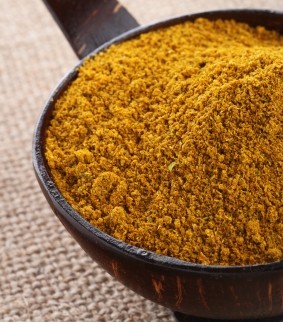 |
| Cape Town Harbor with Table Mountain in the distance. Photo by John D. Lewis |
The South African journalist and poet Rustum Kozian told me that his mother always made a Cape Curry with a very simple mix of cumin, turmeric and coriander. His father, on the other hand—who was of Indian descent—far preferred the hotter Durban curries and complained about the Cape curries being “too yellow and too mild.”
In Leipoldt’s Cape Cookery, written in the 1940s, South African poet and gourmet C. Louis Leipoldt gave a charming description of preparing spices for Cape Malay curry:
Take a copper mortar, dusted with buckwheat meal, and place in it diced red chiles, diced green chiles, two tablespoonfuls of coriander seed, a snippet of green ginger, a pinch of coarse cinnamon… a young orange leaf, a scraping of lemon peel, a clove of garlic, two large spoonfuls of molten butter, a spoonful of turmeric. Now use the pestle, and pound and rub and grind what is in the mortar.
Why the pestle and mortar for the mix?
As his family cook patiently explained, “… it is to get the soul out of it and into the meat…”
 |
The author at the 1761 home of her grandmother “Bergvliet” in Cape Town. Photo by Diana Armstrong |
I was born and raised in Durban, South Africa, and at an early age my Grandma Gertie taught me to love fiery Durban Indian curry. We also visited the home of my Grandma Mary in Cape Town, South Africa. It was there that I began another addiction: to sweet Cape Malay curry.
In the Cape Town of my childhood, Grandma Mary employed two Cape Malay women in her kitchen. One of my earliest memories is of their warm, somewhat toothless smiles welcoming me into their world of subtle aromas. These two ladies comforted me when Grandma Mary would scold me for being a picky eater, and they would cajole me into eating their sweet curry. I learned the secrets of Cape Malay cooking in Mary’s 1761-era kitchen filled with copper pots and uneven surfaces. All the old wooden tables were worn wavy with countless cuts, as wavy as the old 18th century kitchen floor tiles brought for this house from Indonesia.
 |
Bo-Kaap, the Cape Malay quarter of Cape Town. Photo by Barbara Sileo |
No visit to South Africa is complete without a visit to Cape Town, one of the most magnificent cities in the world, and no visit to Cape Town is complete without a visit to the old Cape Malay Quarter called Bo-Kaap. The area’s exotic, neatly stacked artisan houses have been restored and are differentiated by their bright colors of purple, blue, orange, green, and yellow.





